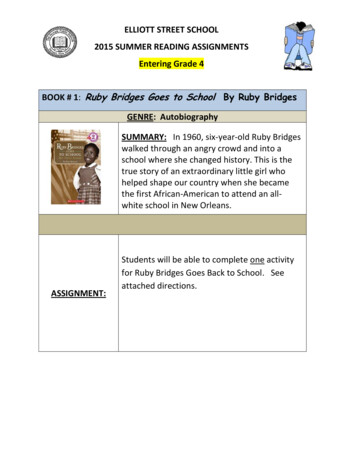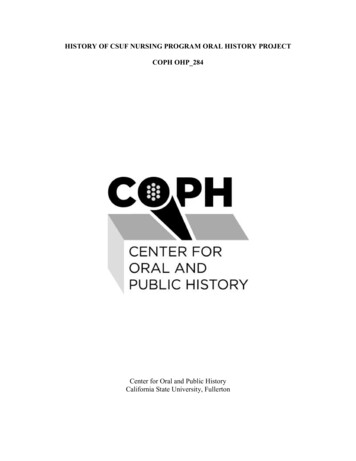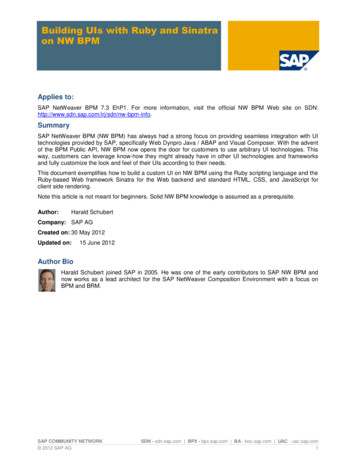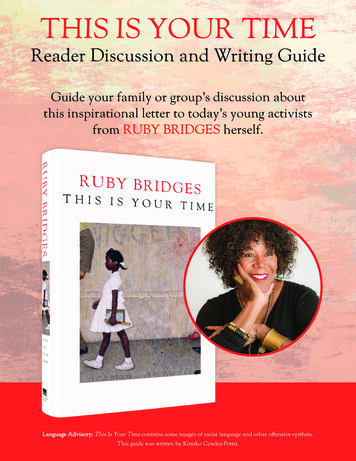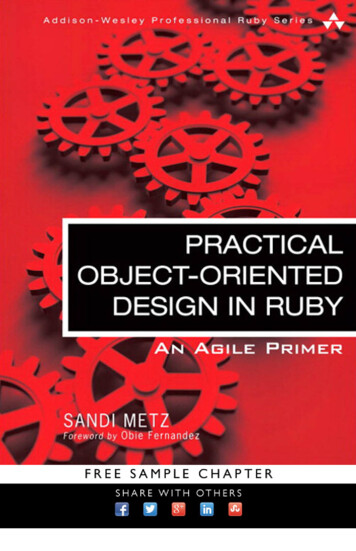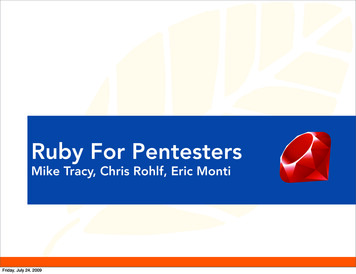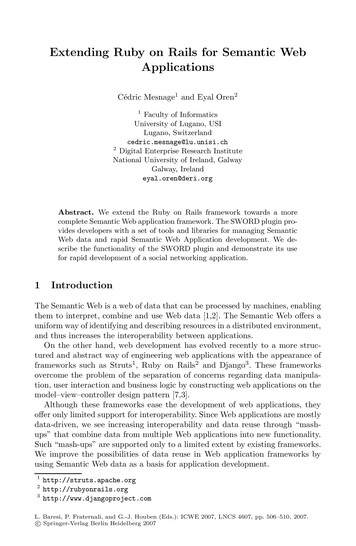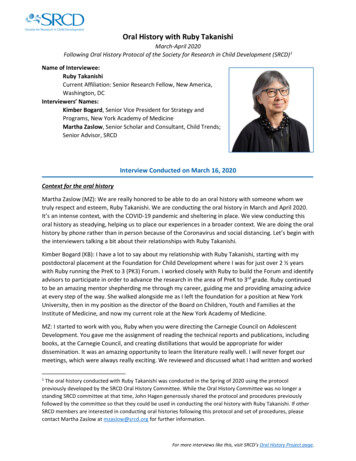
Transcription
Oral History with Ruby TakanishiMarch-April 2020Following Oral History Protocol of the Society for Research in Child Development (SRCD) 1Name of Interviewee:Ruby TakanishiCurrent Affiliation: Senior Research Fellow, New America,Washington, DCInterviewers’ Names:Kimber Bogard, Senior Vice President for Strategy andPrograms, New York Academy of MedicineMartha Zaslow, Senior Scholar and Consultant, Child Trends;Senior Advisor, SRCDInterview Conducted on March 16, 2020Context for the oral historyMartha Zaslow (MZ): We are really honored to be able to do an oral history with someone whom wetruly respect and esteem, Ruby Takanishi. We are conducting the oral history in March and April 2020.It’s an intense context, with the COVID-19 pandemic and sheltering in place. We view conducting thisoral history as steadying, helping us to place our experiences in a broader context. We are doing the oralhistory by phone rather than in person because of the Coronavirus and social distancing. Let’s begin withthe interviewers talking a bit about their relationships with Ruby Takanishi.Kimber Bogard (KB): I have a lot to say about my relationship with Ruby Takanishi, starting with mypostdoctoral placement at the Foundation for Child Development where I was for just over 2 ½ yearswith Ruby running the PreK to 3 (PK3) Forum. I worked closely with Ruby to build the Forum and identifyadvisors to participate in order to advance the research in the area of PreK to 3rd grade. Ruby continuedto be an amazing mentor shepherding me through my career, guiding me and providing amazing adviceat every step of the way. She walked alongside me as I left the foundation for a position at New YorkUniversity, then in my position as the director of the Board on Children, Youth and Families at theInstitute of Medicine, and now my current role at the New York Academy of Medicine.MZ: I started to work with you, Ruby when you were directing the Carnegie Council on AdolescentDevelopment. You gave me the assignment of reading the technical reports and publications, includingbooks, at the Carnegie Council, and creating distillations that would be appropriate for widerdissemination. It was an amazing opportunity to learn the literature really well. I will never forget ourmeetings, which were always really exciting. We reviewed and discussed what I had written and workedThe oral history conducted with Ruby Takanishi was conducted in the Spring of 2020 using the protocolpreviously developed by the SRCD Oral History Committee. While the Oral History Committee was no longer astanding SRCD committee at that time, John Hagen generously shared the protocol and procedures previouslyfollowed by the committee so that they could be used in conducting the oral history with Ruby Takanishi. If otherSRCD members are interested in conducting oral histories following this protocol and set of procedures, pleasecontact Martha Zaslow at mzaslow@srcd.org for further information.1For more interviews like this, visit SRCD’s Oral History Project page.
Takanishi Oral History Interviewto get them to the next step. You always scaffolded, working with me to make them clearer, make themmore useful. Afterwards I was really grateful to stay in touch and to be mentored through all thepositions I have had, including as a researcher at Child Trends and director for policy at SRCD. I continueto be mentored. I am really grateful.Ruby Takanishi (RT): Thank you.Family background and early influencesMZ: We’d like to begin by asking about your family background and your years growing up. Howwould you say your upbringing influenced the early years of your career and your educational andprofessional choices?RT: Well, I was born and raised on the island of Kaua’i, in what was then called the Territory of Hawaii.And I grew up in a sugar plantation town. At that point in the 50’s, the small towns on the island weresugar plantations, because the economy was based largely on the production of sugar and to someextent the production of pineapple.So, I grew up in a sugar plantation town that was dominated by the plant which operated 24 hours a daypretty much. And I was very fortunate because my parents were college-educated. So, my mother wasthe first in her family to graduate from the University of Hawaii and she was a teacher. And my fatheralso graduated from the University of Hawaii. And he took over the family general merchandisebusiness. So, I was quite an advantaged person in the sugar plantation town, but I grew up with andwent to school with children who were, the vast majority of whom, were children of sugar plantationlaborers.And I remember quite vividly growing up, especially in the early 50s, there was successful labororganizing of the sugar plantations. The labor organizing had pretty much started at the end of the 19thcentury and into the 20th century, and it was quite a violent period in history. But finally, after thesecond World War, in the early 50s, labor organizing was successful. But I remember growing up withstrikes that lasted for a very long time, and having classmates whose parents were not working, andsoup kitchens and so on. So I would characterize my upbringing as spending time with the vast majorityof kids of plantation workers, but sort of slightly having some contact with the level you would call thesugar plantation managerial class, whose children pretty much did not go to the public schools.One of the things I would say is that growing up in a multi-ethnic, largely immigrant community, therewere very few children who were Anglo or Caucasian in my growing up. And really the first time Iencountered Anglo and Caucasian people in large numbers was when I went to college. So, I had thiskind of experience of being quite advantaged in terms of my parents’ education, and my mother being ateacher, being exposed to books and current issues.I think the thing that is important is that my mother had never trained to be a teacher, which was herprofession. But it really took her until my senior year of high school when she completed all of thecourse requirements for her to be certified as a teacher in the Hawaii public school system. So, I reallykind of remember growing up as a student in elementary school, and my mother studying and writingpapers, and reading books and papers like by Kenneth and Mamie Clark, I remember so well RachelCarson’s book Silent Spring. And growing up in that kind of environment, which was quite different frommost of the children in my town.My elementary school, Kekaha Elementary School, and my high school, Waimea High School, both publicschools, are still the Western most elementary school and high school in the United States. They still2
Takanishi Oral History Interviewboth function. The students are mostly from immigrant families and people who work in the touristindustry in Hawaii. It is very much a distressed community, given the wages and so forth. And now withthe Coronavirus many are out of work.So, I think I had the sense early on that since my parents were college-educated and had a comfortableincome level, certainly a middle-class income level, that I was quite an advantaged person in thatsetting. And the other thing that I would say that was really important is that just because of historicalcircumstances with the Russian launching of Sputnik, and the American governmental response interms of supporting new math, new biology, new physics, I really benefitted from that, because it wasmy teachers in the sciences and mathematics who were able to go to the mainland and be trained in thenew curricula, and brought them back certainly to my high school, and were able to share those withme. So, I felt that I had a very strong training or education in the sciences and mathematics because ofgovernmental investment in teachers at that point. I think it was called the National Defense EducationAct or something like that. So that was extremely important.And I think the other extremely important tuning point was that by the sixth grade, I was pretty muchgoing to turn out to be a school dropout. I wasn’t particularly challenged in school, and found it quiteboring. And I just wasn’t a very strong student. But in the 7th and 8th grade again just by circumstances, Iwas selected to be in a gifted and talented program based on standardized tests at that time. And itinvolved about 10 people in my grade level from the western half of the island. And so, we were in thisspecial program for a couple of years with teachers who specialized in teaching the so-called gifted andtalented. We had an educational experience that was quite different from what everyone else washaving. And then by high school, I went back into the normal high school. But I also had these teacherswho had gone to the University of Illinois at Champagne-Urbana and to the University of Wisconsin atMadison and who had really learned about new ways of educating high schoolers. And I was anenormous beneficiary of those programs. It really showed me that governmental investment ineducation and teachers is so crucial, certainly in my development, and I think in other people’sdevelopment.MZ: Such a range of experiences both in terms of how the children in your community were growingup and then also what the range of educational experiences might be like, all the way from boring tovery stimulating. And the role of government investment. Were there any teachers or particularcommunity leaders who took notice of you at that point or influenced you? Who would you say wereyour earliest influences?RT: Well so, in the gifted and talented program, there was an enormously inspirational teacher whoreally loved teaching and really loved science. His name was Takeshi Fujita. He was trained, he would goto Boston University and other places from time to time to be trained. But we had this incredibly richeducation. It was an education that was very much experiential and hands on with direct experience.And this was in the sixth and seventh, or rather seventh and eighth grades, so you can imagine what thiswas like compared to what everyone else was having, which was certainly kind of standard didactic kindof education without any direct participation. He passed away very recently. He was very much belovedby all of the students who had contact with him. We would go on excursions, we would go to thebeaches and collect samples of marine life or we would collect botanical specimens, and so forth. It wasan incredibly rich experience. In the sciences I had another teacher named Bill Higa who had beentrained at Wisconsin in teaching chemistry and physics. He was very very important. In mathematics Iwas able to learn new mathematics from a teacher named Ruby, Ruby Doi. There were teachers whowere really wonderful.3
Takanishi Oral History InterviewI should say, these teachers were rather unique. I would say that most of the teachers I had inelementary school and in high school were not like these teachers. So clearly I had some pretty big gapsin my education. I would say that basically that I had a fine basic education in many of the subjects,certainly in English, for example, and social studies. But they were not very deep at all. They were quitesuperficial, were text-book based, and so forth. But that was not the case in the sciences. I myself wasextremely interested in the sciences, did science projects, really loved science.I think this is really important-- when I applied to college, I remember, at that point you had to write a100-word essay. I don’t know what it’s like now, but I really do remember my college essay of 100words. And basically the theme of it was that I was really interested in how science could improve thelives of children, because I had seen many children and many classmates growing up in conditions, youknow, conditions that were low income conditions. The sugar plantations were very, what shall I say,they were like patrons. So they provided the housing, they provided the health care and so forth. Butthe wages were quite low, because these were agricultural workers.So, I had a sense very early on that there were so many people that were so talented, smart andintelligent, but didn’t have the opportunities that I had. And so, I was quite aware of this very early on.And what I think my college essay did was to sort of combine this very strong interest that I had in thesciences and the scientific method with a feeling that there were very drastic inequalities in thecommunities and schools I went to. The schools were tracked. There were always a few kids who sort ofgot the best. And then there were kids who were in the lower tracks who, you know, were not beingwell educated. And I think I understood this quite early on. And so, that was my college essay--how tobring the methods and resources and approaches and ways of thinking about science, the sciences, toimproving the wellbeing of children. I always liked children. I think that was very important in going tocollege and deciding to major in psychology and in developmental psychology.MZ: It’s amazing how that college essay anticipated many of the themes that followed. I want to askyou to turn to your college experiences. But first, Kimber, is there anything else about familybackground and years growing up that you want to ask about or shall we move on?KB: No, I thought that was a very rich and full description. Ruby, I actually understand a lot more nowabout your trajectory and sort of where it all started, so thank you for all of that information.College and choice of professional fieldMZ: You’ve already answered our questions about the goals you had in your high school years. Thatessay just wove it all together, and the awareness of the range of children’s experiences. Could youturn now to how you made the transition from high school and that community setting to college andinto psychology as a professional field? Please start with your decision to go to college.RT: Sure. Yes. So, I went from this very small sugar plantation town with a population of 2,000 and apublic school that was, you know, adequate but had these incredibly rich experiences along the way, toStanford. And I remember going to Stanford, and it was a cultural shock. It was quite amazing. Inaddition to what every kid goes through when they go to college, I had the additional challenge of beingin an environment which was quite unfamiliar to me. The thing I remember the most was-- that was thefirst time I had been in an environment where most of the people were white, were Anglo. At that pointStanford had very few African Americans. There were also very few Asian Americans in my class whichwas about 1,600. And so, it was, I like to say that it was the kind of environment where you could go formonths and not see a person of color. This has really changed now. The demographics of StanfordUniversity have changed a lot since then, but that’s the way it was.4
Takanishi Oral History InterviewSo I had to adapt and adjust and learn how to be a student in an environment, who lived in a dorm,where a lot of people certainly had not had the experiences I did. One of the things I sort of say in ajesting manner, is that I noticed in the first few weeks or months that I was at Stanford that I couldnever remember people’s names. And I think part of it was that I really had to adjust to the fact thatthese were, you know, completely new human beings that I was relating to because I had never hadvery much experience relating to Anglos or Caucasians or white people or Black people. And I rememberone other student who came from Shaker Heights in Ohio and who was Black and going through some ofthe same things. We kind of bonded.All of that in addition to being in an intellectual environment where people had really good educations,had gone to the best high schools and private schools in the United States. I must say I was quitedisoriented. But I did manage to make it through.MZ: Ruby, what helped you navigate that situation?RT: I think that is a very important question. I think it was that I felt that education, certainly in myupbringing, in Japanese and Japanese American culture, the importance of education, doing well ineducation, was at that point, extremely important to my family and to me. Even though I reallystruggled a lot, I really felt that I have to keep my focus. I am a focused person, so I was able to do that.But it was hard.I still remember in my freshman English class, a woman was talking about the Great Books. I had no ideawhat she was talking about. I think what I mean is that I had the basics, but I didn’t have sort of a deepwide-ranging education at all. I had a lot of catching up to do.And the other thing that I would say, is that, just because of the selection process at that point atStanford University, you really had a lot of people who, I felt, felt very entitled, and very sure ofthemselves. And so, I had to struggle with that as well. And I think the way I did it, was to, to sort of try,as my mother would say, as we say in our Japanese-American culture, “Always do your best.” So, I wouldalways try to do my best. And I think that really helped me.But it was quite a period of disorientation. I mean, food, for example, you know was different, peoplewere different, cultural processes were different. And so, I really had to try to address that. And I thinkthe focus on my studies was a very important thing.MZ: During this period, when did you take your first psychology course or education course? How didyou begin to move in the direction you eventually took?RT: When I started at Stanford, I had a very strong science course of work: chemistry, calculus, all of thatkind of thing, in addition to the required Western civilization and English and so forth. So, I took my firstpsychology, introduction to psychology, course in the summer of 1965, when I was at the University ofHawaii. I knew I was going to major in psychology and certainly developmental psychology and so forth,so I needed to get that out of the way. So I never took the intro psych course at Stanford, which was awonderful course that was taught jointly by J. Merrill Carlsmith and Thomas Landauer; it was kind oflegendary. I didn’t have that course.And then when I came back to Stanford as a sophomore, I took Eleanor Maccoby’s developmentalpsychology course, which I absolutely loved. And at that point, Stanford was very much a liberal artscollege. And so, they limited your major to 45 credits of psychology. You couldn’t, even though I wantedto take every psychology course that existed, I couldn’t because that was against the rules. So, I had to,as I said, take humanities courses and music courses and literature courses as requirements for the5
Takanishi Oral History Interviewdegree, which were such that you did have a quite broad education. And I think that was certainly verygood. You know, biology, anthropology, sociology. So, in that sense the Stanford liberal arts educationat that point really educated you in a very broad way in addition to your major.In terms of research, conducting research, I first went to work with Leonard Horowitz (I think he mightstill be alive). He was a very beloved psychology professor at Stanford. We did some, experimental workand that was actually published in an experimental psychology journal (Horowitz, Lampel and Takanishi).Starting in my junior year at Stanford when you declare your major and you got to focus more onpsychology, I started to work with Eleanor Maccoby. She was starting her attachment studies at theuniversity. And developmental psychology, because of Eleanor and others was quite a strong program.She took me under her wing. And I got to go to the seminars at Owen House and listen to seminars byHarold Stevenson and John Hagen who were graduate students in the Stanford program who have goneon to careers in their own universities. Working with Eleanor was really a wonderful experience. And shewas at the beginning of her attachment studies, setting up experimental situations. I also did that withThomas Landauer as well, because he was part of Owen House and we did some research together. Thatwas a really wonderful experience.At the same time, because I was so interested in children and their education, I did something whichmight have been quite unusual for a psychology major at Stanford. I also went to work at Bing NurserySchool. Bing Nursery School was a laboratory nursery school at Stanford University, and it was run byEdith Dowley, who was a nationally known teacher, early educator, who had worked in the Kaiser ChildDevelopment Centers during the second World War. And she also was a mentor and kind of took meunder her wing. So I was working as a teacher’s aide in the Bing Nursery School, and at the same time, Iwould be behind the one-way mirror in the nursery school conducting research with Thomas Landauerand Eleanor Maccoby and her graduate students, and being able to go to the seminars, and you know,have a bit of a personal relationship with Eleanor and her young children, her young children whoprobably now are 60-70 years old. And, of course, Eleanor was married to Nathan Maccoby who was awonderful professor in the communications department.The honors psychology program at Stanford was a really important one. And one of the people who wasin it was Steven Suomi, who built on Harlow’s work at the National Institutes of Health. And it was, justbecause in chemistry you were assigned to a lab alphabetically, and Suomi and Takanishi were next toeach other. So that is how I knew Suomi. He was also in the psychology honors program which was arather small one.Working with Eleanor, my thesis, my senior honors thesis in psychology, was focused on sex differencesin the attachment behavior of children that were observed in the Ainsworth experimental setting. It wasalso during that period of time that Eleanor and Carol Jacklin were writing their book on sex differencesbased on the extant studies. It was really very wonderful to have contact with these individuals.And I think that Eleanor was so important because she was a woman, and she believed in science, andshe also was, I would say, very politically and socially active. But she was able to kind of have a linebetween her social activism and her science. And she really believed strongly that psychology was ascience. I still remember her saying to me “Ruby, psychology is a science.” But she also had ideals aboutsocial justice. The Vietnam War was very salient at that time. And so, I had a person who was obviouslyso confident in her own right, had children, had social values that were very strong.One thing that I thought was very interesting about Eleanor is that she, until I think pretty much until the90s, when she was on the Board on Children, Youth and Families at the National Academy of Science,she always had a skepticism about the application of research to social program issues. I remember6
Takanishi Oral History Interviewreally having a conversation with her about this early on, maybe in the early 70s, because she was calledon to do things, and she would say “I just don’t know whether I should do this.” So on the one hand shehad, you know, very strong social values, but on the other hand I think she struggled with how toconnect them, which I think really emerged after she retired from Stanford and did the work withRobert Mnookin on joint custody and research like that.So that was my experience at Stanford, and she was very influential in advising me about graduateschools. She graduated from the University of Michigan where I went. I was very fortunate to havesomeone like that in my undergraduate years.Graduate schoolMZ: What a wonderful description of the undergraduate years and about going from a sense ofdisorientation to increasing clarity and focus about what you wanted to do. You were beginning totalk about Eleanor Maccoby encouraging you to go to University of Michigan. Could you talk abouthow you decided to go to graduate school and if you decided right away to pursue a doctorate? Andtell us some about that transition to graduate school.RT: Well, at that point my undergraduate years were quite focused on psychology and doing research,and of course my participation in the nursery school, and so as I remember it, there was, you know it’sall generational, but I just didn’t have any question that when I graduated from Stanford, I was going togo to graduate school. So I applied to graduate school, applied to what were considered to be some ofthe strongest psychology and developmental psychology programs in the country, and decided to go tothe University of Michigan where Eleanor had done her work.And I remember graduate school because John Hagen was there. I don’t know to what extent, maybeJohn had something to do with it as well, because John had graduated from the graduate program inpsychology and developmental psychology at Stanford. But the Michigan graduate program at that pointwas very large. I think the incoming graduate numbers were about 60 graduate students in psychologyin all of the specializations of psychology. There was clinical, and experimental, and social and all of that.And the developmental psychology program had five incoming students, one of whom was Lynn Liben,so Lynn was in my class, in my cohort. One left and became a lawyer and I did not keep track of theother two.So we were a little subgroup in developmental psychology for a while in the psychology department,which was quite large. And Marty Hoffman, Martin Hoffman, was one of the professors there. It didn’thave a large group of people and certainly didn’t have a large faculty. But John Hagen and MartyHoffman were some of the main people. And I remember taking courses in social psychology and all ofthe others. And because I had had a very strong undergraduate psychology program at Stanford, I wasable to get my masters degree from the University of Michigan in two semesters. And so that was veryhelpful. I mean I did take a full course load and learned a lot from the other psychologies as well. Butbasically my home base was developmental psychology, the cohort of five, John Hagen and MartinHoffman.I think I would say because of the period, it was, ‘68-‘69, developmental psychology was not what it istoday. It was probably, what should I say, it was lesser, it wasn’t as prominent as social psychology forexample, or experimental psychology. It was really years afterwards that developmental psychology kindof came into its own. So, it was a small program. I guess I would say it wasn’t a high status specializationin psychology at University of Michigan. But I think our little group of five had a kind of a comradery thatwas quite good. So that was Michigan.7
Takanishi Oral History InterviewThen in ‘69 I moved to the University of Chicago. I had gotten a fellowship which was really pivotal in mydevelopment. It was a National Institute of Mental Health fellowship. It was a grant that supportedindividuals and I still have contact with some of these individuals. The program was called SocialPsychologists for Schools. At that time, NIMH had scientific officers who were extremely innovative andforward-looking and who were trying to think of training programs and ideas and approaches that werevery forward-looking. The idea for this NIMH fellowship at the University of Chicago was that it was totrain individuals, not to be school psychologists working with individual students, because by then ofcourse I was very very interested in the intersection of psychology and early education and education ingeneral, but it was to train individuals who knew the social organization of schools, and who wouldreally work with teachers and principals to help them understand the functioning of the schools, andthat by working with these adults there would be ramifications for the students. There was a group ofus, maybe there were about five fellows, I don’t remember exactly, but who were active in this program.Part of the experience, in addition to coursework at the University of Chicago which had reallywonderful professors--Bruno Bettleheim and Robert Dreeban in the sociology of education program,and they had the most wonderful people—after a period of time, we were placed in a school. And it wasan incredible experience.MZ: How did you come to understand the social structure? Was it from the immersion experience?RT: That’s important. What we had was, the other half of the fellowship, which was funded by theNational Institute of Mental Health, was coursework. We had coursework in the sociology of education,and social psychology of groups was a very important part of that. So we had, I guess I would call it, theintellectual foundations. It was basically a kind of ethnographic case study approach in which you werealso trained in your classes and you were a participant observer basically in these schools. And youwould hang out in the teacher lounge, and you would hang out in the halls and then in the classrooms.And you would observe contacts between teachers and students. And the coursework at the Universityof Chicago, and the internship I guess as it was called, were very much aligned.And that experience was again extremely pivotal in the work that I did since. When I think about it, I seethat the fellowship was the starting point of three themes that continued throughout my work. First, Ilearned how important it is to have an understanding of the daily experiences of teachers and childrenin schools. I returned on multiple occasions to have immersion experiences in schools and also in earlychildhood education. I don’t think it is possible to apply developmental science to educational settingswithout really engaging in these settings. To be effective in applying research to educational practice, Ithink, requires a depth of understanding of educational settings and how they function.Second, I learned tha
with Ruby running the PreK to 3 (PK3) Forum. I worked closely with Ruby to build the Forum and identify advisors to participate in order to advance the research in the area of PreK to 3. rd. grade. Ruby continued to be an amazing mentor shepherding me through my career, guiding me and providing amazing advice at every step of the way.


